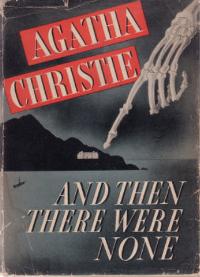
Merry Christmas! Towards the end of her career, Agatha Christie books were published as "A Christie for Christmas". In the 1960s, when her output slowed, her publishers tactfully let it be known that they'd let her off the hook and publish a "Ngaio Marsh for Christmas". The result was By The Pricking Of My Thumbs by return of post.
Even today, Christie adaptations glut the festive schedules - it seems we all love a good murder and a mince pie, and the nostalgic world that Christie evokes seems as much a part of the myth of Christmas as roaring fires, carol singing, snow and mince pies.
Viewed nostalgically, it seems surprising that more Christies aren't set at Christmas. There is, I think, this book, a Poirot short story and the first Harley Quinn mystery sees in the New Year. And that's about it.
Oddly, Hercule Poirot's Christmas is not a very Christmassy book. The Sittaford Mystery is at least snowier - indeed, the lack of Christmas decorations forms a late plot point, when Pilar Estravadors discovers them in a cupboard and comments on her expectations of "the crackers and the burning raisins and those shiny things on a tree..."
Christmas is simply an excuse for wicked old Simeeon Lee to gather his family around him - yes, it's the good old country House of Evil again, with the miserable live-in relatives, the exotic strangers from abroad, the returning prodigals, and curious servants, mixed in with impostors and spongers. This is pretty much the set-up of A Pocket Full of Rye, bolted onto the structure of a typical Poirot (death-interrogation-revelation).
If it all feels a little staged, this turns out to be part of Christie's plan. She even allows a character to comment "this is one of those damned cases you get in detective stories where a man is killed in a locked room". The reader will even spot the point, two-thirds in, where Poirot solves the murder and simply treads water until it's time to reveal the solution.
That this is a "locked room" murder is actually quite extraordinary in Christie's work. She adores the impossible mystery, but normally avoids the obvious impossibility of the locked room, leaving those to Carter Dickson. That she's chosen to employ this device is very deliberate here - she is throwing the reader's mind to thinking "how did the villain commit this crime and escape" rather than "why was the room locked in the first place?"
The whole thing is an elaborate sleight, which becomes quite easy to resolve once you realise who the murderer is. This is theoretically quite easy in this book - Simeon Lee drops several unconscious hints before his demise which Christie frequently reinforces - but in practice you may well miss it because it's just not where you're looking.
Again this is down to Christie. By the end you realise that this book is deliberately formulaic - the old house, the sequential interrogations, and other trusty bits of Christie's false machinery all wheeled out to keep you baffled.
This is helped by the book's mostly pallid characterisation. It's quite easy to forget who is who among the Lee clan (oh! so many brothers and wives). Christie even jogs your elbow by introducing Pilar Estravados, Lee granddaughter, who is the most striking woman in the book. So wonderfully radiant is Pilar that it makes the other Lee women very dull indeed, and even casts most of the men into shadow. Pilar is magnificently unBritish and unsentimental - she likes Simeon Lee, despite his immorality, she is unabashed about her selfishness, and isn't ashamed to be an adventuress, which throws her up against the book's two returning colonials, who are again rather less interesting.
Pilar, indeed, draws so much attention that the book becomes a did she/didn't she. If she did, then it's disappointing, but if she didn't, then who could possibly be as satisfying a villain? So bright is her star that it's impossible to forget that, as everyone admits, she had nothing to gain by killing Simeon Lee. Or did she, after all?
At the end of it all, Hercule Poirot's Christmas is a great example of what appears to be a by-the-numbers work by a master of the genre, but is, in fact, rather more than that.
Next: Yuletide merrymaking continues with The Adventure Of The Christmas Pudding



 A brief look at the Poirot TV series
A brief look at the Poirot TV series
